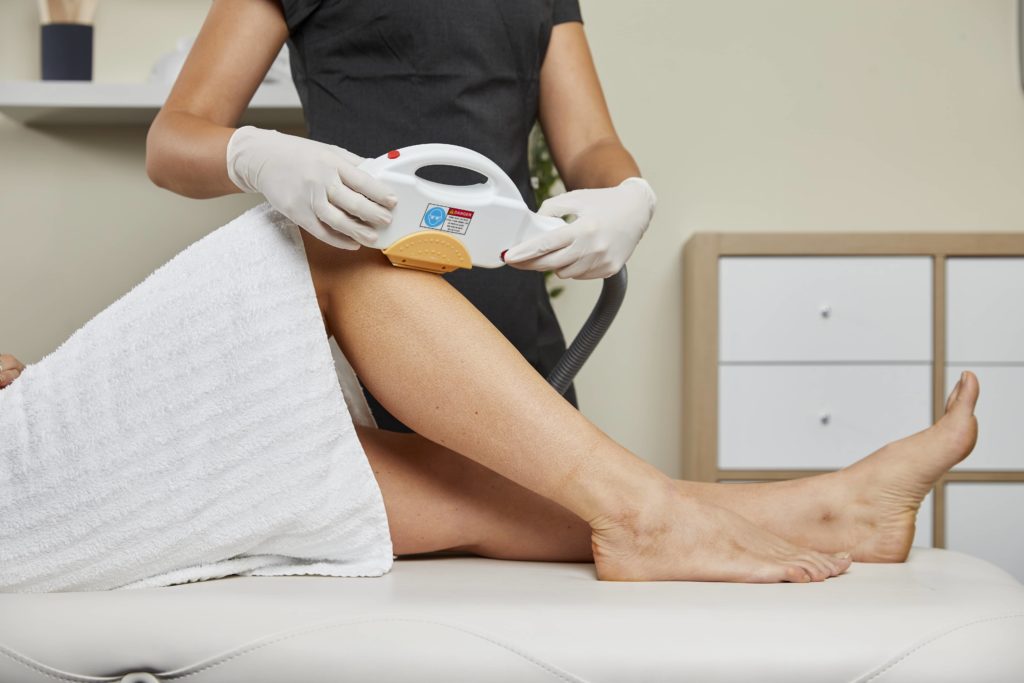Ok so laser hair removal is nothing new – it burst upon the scene 10 plus years ago as an absolute game-changer in terms of hair removal as a cost-effective alternative to other less effective methods such as waxing or shaving. Thanks to advances in technology, laser hair removal can now cater to more people and those with darker complexions and lighter hair are now suitable candidates for the different types of laser hair removal on the market.
So, you have decided to take the plunge – you are sick of shaving stubbly legs and dealing with ineffective and painful gadgets that promise the world but under deliver. We had a chat to the salon supplier The Global Beauty Group, to break down the basics.
How does laser hair removal work?
Hair removal laser machines work by using targeted light (the laser) to target and affect the hair follicle, heating it up and essentially damaging it so that it cannot grow hair anymore. A laser (which is essentially a concentrated beam of light) is directed towards the base of the hair follicle, killing it at the root.
How long before the hair grows back?
It will usually take several weeks to months for the hair to grow back, depending on the thickness of the hair. Each time you get treatment, more hair is targeted thus there is less to grow back each time. The hair that grows back is finer and takes longer to grow back after each session.
How many sessions will I need?
Laser hair removal is an investment, you have to commit to a series of 6-8 treatments, approximately 6 weeks apart. Some people will require more, some less. It varies on the treatment area and size and other contributing factors such as the type of hair and how thick it is to start with. You should notice a reduction in your hair growth after the first few sessions.
What is the difference between SHR, IPL and normal laser hair removal?
SHR stands for Super Hair Removal and IPL stands for Intense Pulsed Light.
All 3 hair removal devices use targeted light to affect the hair follicles, the difference is basically the type of light, laser is a one-shot deal; a single pulse of light at one set wavelength, standard IPL is similar but uses a scattered light pattern to target the follicle. SHR treats the area by heating up the hair follicle slowly, using multiple flashes of light.
So, what does that mean for me?
Well for starters, talk to your clinician about the colour of your skin and hair. They will then determine which type of laser hair removal is suitable for you and if you are a candidate for SHR or IPL. For SHR, the hair needs to be darker than your skin tone. IPL is suitable for a wider range of hair colours, including dark blonde and red hair although more sessions may be required.
What will happen during my appointment?
First, your clinician will thoroughly cleanse and sanitise the area. You will be given a pair of black-out goggles to protect your eyes from the light. Next, a cool laser gel is applied to the area which is to be treated. If you have not had a test patch prior, your clinician will likely do a test patch first to see how your skin reacts. They may need to adjust the settings accordingly to find the appropriate level ideal for your skin type and sensitivity.
Depending on the type of hair laser removal machine – each section will be pulsed with the laser beam. It feels like a light warm zap of static.
SHR is a much faster treatment due to your clinician being able to treat much larger areas with ease. Rather than IPL which uses a stamping motion – the laser is rolled back and forth over your skin, making treatments much more comfortable also.
Most places that offer SHR will have standard IPL also, which is still a fantastic tool that can be used to treat smaller more difficult or hard to reach areas.
What can I expect after my laser hair removal?
Body hair will take 2-3 weeks to fall out, whereas facial hair only takes 7-10 days. Individual results will depend on your skin type, hair coarseness and your body’s natural growth cycle.
Afterwards, you may experience slight tingling but it is extremely mild. You may also see/develop some red bumps on the surface of the skin – do not be alarmed these are perfectly normal and in fact mean that the treatment has been successful. They should subside within 72 hours but you can take an antihistamine or apply calamine lotion to speed up the process. Aloe vera gel also works very well.
No working out immediately after as sweat can irritate recently laser-treated skin. Try and avoid super hot showers or baths for 24-48 hours.
Can I get laser hair removal everywhere?
The short answer is YES! Laser hair removal can be performed on sensitive areas such as the face, neck, bikini line etc as well as underarms, arms, legs
What not to do before getting laser hair removal:
Shave the area the day before treatment. Avoid waxing or plucking hair (anything that pulls out the root of the hair) for 2 weeks. It is also essential to avoid sun exposure and/or tanning for at least a month prior to treatment and use sunscreen on any areas that may be exposed to the sun.





